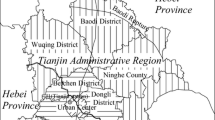Abstract
Construction in a new neighborhood in the israeli town of Dimona, situated in an arid region in the south of the country (150 mm average annual rainfall), resulted in a rise in groundwater levels during the subsequent rainy seasons This caused flooding of shelter basements, soil sliding, and sagging which permanently damaged walls and buildings The neighborhood had been built on continental sands and marls blanketed by loess, on a valley slope near a rocky anticlinal dip-slope
Subsurface studies, using piezometer holes and groundwater analyses, revealed the presence of sand lenses alternating with plastic marls, which act as seasonal aquifers with perched water tables Groundwaters obtain high SO −24 and Cl− corrosivity through contact with these nonflushed marls of the Neogene valley fill (Hazeva Formation)
The reasons for the rising of groundwater were found to be (a) artificial interference with the natural (pre-construction) drainage system—interception of the hillside runoff by building plots, roads, etc, (b) partial denudation of the loess blanket, increasing the local infiltration and the build-up of local, perched water tables, and (c) corrosion of concrete and steel pipelines, as well as foundations, by prolonged contact with corrosive groundwater, resulting in haphazard but massive leakage
Guidelines are proposed for an environmental improvement plan, which would include terracing and planting of the watershed above town to increase evapotranspiration, lowering of the water table by pumping, and diverting the water to suburban parks (groves of saltresistant trees), and replacement of steel and cement pipes by a non-corrodable plastic pipe system
Similar content being viewed by others
References Cited
Adar, A., 1978, Infiltration to channels' beds as result of floods in the northern Negev Israel: M Sc thesis, Jerusalem, The Hebrew University, (in Hebrew).
Aitken, A. P, 1975, Hydrologic investigation and design of urban stormwater drainage systems: Canberra, Research project no. 71/22 of the Department of Environment and Conservation, Australian Water Resources Council, Australian Government Publishing Service, 140 p.
Arkin, Y., and M. Brown, 1965, Type sections of Upper Cretaceous Formations in the northern Negev (Southern Israel): Jerusalem, Geol. Surv. Stratigraphic Sections 2a, 19 p.
Evenari, M., L. Shanan and N. A. Tadmor, 1971, The Negev: The challenge of a desert: Cambridge, Mass., Harvard University Press, 345 p.
Gvirtzman, G., and B. Buchbinder, 1969, Outcrops of Neogene Formation in the Central and Southern Coastal Plain, Hashphela and Beer Sheva regions, Israel: Jerusalem, Geol. Surv. of Israel, Bull. no. 50, 52 p.
Harash, A., 1967, The geology of the Yeroham-Dimona plain: M.Sc. thesis, Jerusalem, The Hebrew University, (in Hebrew).
Hillel, D., and D. Tadmor, 1962, Water regime and vegetation in the Central Negew highlands of Israel: Ecology, v 43, no 1, p. 33–41
Kutiel, H, and D. Sharon, 1980, Diurnal variation of rainfall in Israel: Arch. Met. Geoph Biokl., ser. A, v. 29, p 387–395.
Lambe, T. W., and V R Whitman, 1969, Soil mechanics: New York, John Wiley & Sons, Inc, p 553.
Leopold, L. B., 1968, Hydrology for urban land planning—a guide-book on the hydrologic effects of urban land use: Washington, Geological Survey Circular 554, United States Department of the Interior, 18 p
Nativ, R, A. Issar, and J Rutledge, 1983, Chemical composition of rainwater and floodwater in the Negev Desert, Israel: J. Hydrology, v 62, p. 201–223.
Neev, D, 1960, A pre-Neogene erosion channel in the Southern Coastal Plain of Israel: Jerusalem, Geol. Survey of Israel, bull no. 25., 21 p.
Pfeilsticker, K., 1981, Deuterium und18O in regen, luft-, und bodenfeuchte von Sde Boqer (Negev), lokaale grundswasserspende: Heidelberg, diplomarbeit am Institut für Umweltphysik, Universitat Heidelberg, 48 p
Shahar, Y., 1973, The Hazeva Formation in the Oron-Ef'e Syncline, Israel: Israel J. Earth Sci., v. 22, no. 1, p. 31–49.
Tadmor, N. H., G Orshan, and E. Rawitz, 1962, Habitat analysis in the Negev desert of Israel: Bull. Res. Counc. Israel, v. 11, pp. 148–173.
TAHAL, 1979, Geotechnical survey in the northern neighborhoods of Dimona: Tel Aviv, TAHAL, Water Planning for Israel, Ltd., 11 p.
UNESCO, 1974, Hydrological effect of urbanization: Paris, Report of the sub-group of effects of urbanization on the hydrological environment, The UNESCO Press, p. 280
Yair, A., D Sharon, and H. Lavee, 1978, An instrumented watershed for the study of partial area contribution of runoff in the arid zone: Zeitschr. Geomorpho. Suppl., v 29, 71–82.
Yair, A., D. Sharon, and H. Lavee, 1980) Trends in runoff and erosion processes over an arid limetone hillside, northern Negev, Israel: Hydrol. Sci. Bull. v. 25, no. 3, p 243–255.
Author information
Authors and Affiliations
Rights and permissions
About this article
Cite this article
Karnieli, A., Issar, A. & Wolf, M. The effect of urbanization in an arid region: Formation of a perched water table that causes environmental damages. Environ. Geol. Water Sci 6, 51–63 (1984). https://doi.org/10.1007/BF02525570
Issue Date:
DOI: https://doi.org/10.1007/BF02525570




